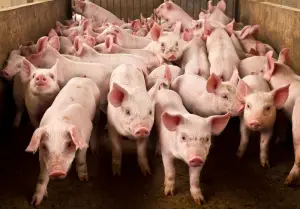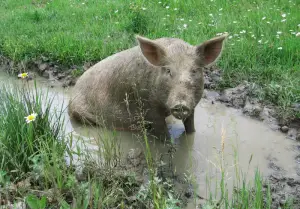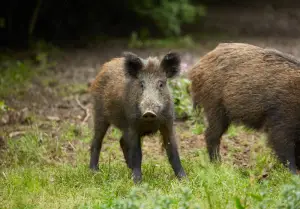Differences Between A Pig and A Hog
Pig and hog – you’ve likely heard both of these terms, seemingly referring to the same animal. Not only do lay people use the terms interchangeably, but farmers usually use them interchangeably as well. Is there a difference between the terms “pig” and “hog”?
What is the difference between a pig and a hog? Many farmers use the word “pig” to describe a young pig that is not yet ready for market, and weighing less than 120 pounds. In most regions, however, “pig” is used to refer to any domesticated, feral, or wild swine. The word “hog” is used to describe a large pig that has reached market or hunting weight, specifically weighing 120 pounds or more.
Read on to learn more about the different terms related to swine, and why we use different names for the same animal.
Why There’s Confusion Around The Terms Pig And Hog
Pigs belong to the Suidae family, which includes 19 different species. These species include the Common Warthog, the Bushpig, the Bearded Pig, the Red River Hog, the Vietnamese Warty Pig, and the Domestic Pig. Do you hear a common theme among this family of animals?
Most of the names include either the word “pig” or the word “hog”, and most of them share many physical and behavioral traits. Because the members of the Suidae family are so similar, it can be easy to confuse them for one another. This may be one of the reasons we use the terms “pig” and “hog” interchangeably.
Pig Or Hog: What Does The Dictionary Say?
Let’s look at what a couple of popular dictionaries have to say about these terms.
From the Merriam-Webster dictionary:
- Swine: “any of various stout-bodied short-legged omnivorous artiodactyl mammals (family Suidae) with a thick bristly skin and a long flexible snout”
- Pig: “a young domesticated swine usually weighing less than 120 pounds” or “a wild or domesticated wine regardless of age or weight”
- Hog: “a domesticated swine especially when weighing more than 120 pounds” or “any of various animals related to the domesticated swine”
From dictionary.com:
- Swine: “any stout, cloven-hoofed artiodactyl of the Old World family Suidae, having a thick hide sparsely covered with coarse hair, a disklike snout, and an often short, tasseled tail: now of worldwide distribution and hunted or raised for its meat and other products”
- Pig: “a young swine of either sex, especially a domestic hog, Sus Scrofa, typically weighing less than 300 pounds” or “any wild or domestic swine in teh genus Sus, within the family Suidae”
- Hog: “a hoofed mammal of the Old World family Suidae, order Artiodactyla, comprising boars and swine” or “a domesticated swine weighing 120 pounds or more, raised for market”
As you can see, the clarity between the terms swine, pig, and hog is not well-defined.
Differences Between Domestic, Feral, And Wild Pigs
Within the United States, you will find domestic pigs, feral pigs, and even wild pigs. What is the difference between the three, and what are they commonly called?
Domestic Pigs 
Domestic pigs are the farm pigs that we are all familiar with. There are many different breeds of domestic pigs, with eight breeds comprising the majority of the farm pigs in the United States. These breeds are the Yorkshire, the Duroc, the Berkshire, the Chester White, the Pietrain, the Poland China, the Landrace, and the Hampshire.
Most of these breeds have similar body compositions and reach a mature weight of between 500-700 pounds. The Landrace is unique in that it has been bred to have a particularly long body to increase the production of belly bacon.
Most of us think of the classical pink pig with pointy ears when we think of a domestic pig. But pigs come in a wide variety of colors and markings and can have either erect ears or floppy ears.
Many pig farmers choose the light pink pigs such as the Yorkshire and the Chester White because the light hair allows for a more visually appealing carcass – this may be the reason that we associate farm pigs with pink pigs. Other breeds come in red, brown, black, and white colorings with solid, spotted, or belted patterns.
Wild Hogs
Many of us are familiar with wild hogs, otherwise known as wild boar. True wild boars are native to Central and Northern Europe, Asia, and the Mediterranean. They were introduced into the United States to hunt as sport, and are still in the Americas in small numbers.
They are similar in size to domestic pigs and can reach 600 pounds at maturity. They usually have a mottled or brindle-like pattern in either a black to brown coloring or a white to tan coloring. Leopards and tigers are the main natural predators of true wild hogs. Because both leopards and tigers are endangered species with declining populations, wild hogs are increasing in number.
In its native countries, wild hogs are typically considered a nuisance because of the destruction that they can cause to the environment. Hogs use their muscular snouts to disturb the earth while seeking food – this is called rooting and is a natural behavior that all pigs engage in. Because of the destruction that they cause, particularly in farming communities, they are considered a pest and an ecological threat.
Feral Pigs 
It is easy to confuse wild pigs with feral pigs, and many people use the terms interchangeably. They are not the same, however, and most of the time, when someone is talking about “wild hogs”, they are actually referring to feral hogs or feral pigs. There are many more feral pigs in the world than there are true wild pigs.
There is a distinct difference between the terms “wild” and “feral”. A wild animal is one whose ancestors have never been domesticated.
Zebra are wild. Crocodiles are wild. Jaguars are wild. None of these animals come from a domesticated line. A feral animal is one that, at some point in its lineage, has been domesticated.
Feral animals have found their way into the wild and are no longer tame, having lost most of the attributes that come with domestication. An example of a feral animal is the Mustang horses that can be found in the United States, or the Brumby horses of Australia. The ancestors of these horses were once domesticated horses that escaped or were let loose. They are not tame, but they are not truly wild.
There are around 6 million feral pigs in the United States, and they can be found in at least 35 states. These feral pigs are the result of escaped or loosed domestic pigs, and some of them have even cross-bred with the wild pigs that have been brought over from Europe and Asia.
Feral pigs are similar in size to domestic pigs, and they are destructive to the environment like the wild hogs are. Predators of the feral pig include wolves, bear, and mountain lions. Some of these predators, like wolves, are considered endangered species and are in decline – helping the pigs to flourish in number.
Warthogs
There is another animal in the Suidae family that many of us are familiar with, and that is the warthog. Warthogs live in the sub-Saharan African region and are slightly smaller than other wild hogs, reaching a (still substantial) weight of around 250 pounds. Warthogs, like their wild and feral cousins, are considered pests in their native land because of the destruction they can cause and the challenges that accompany population control.
Domestication Of The Pig
Pigs were domesticated by humans approximately 9,000 years ago, making them one of the first domesticated animals. Interestingly, they were domesticated at two independent times – one such domestication took place in China, and the other in what is now Turkey. Because pigs have been walking with humans for such a long time, many names have come to be associated with them.
We know that the terms hog and pig can usually be used to refer to the same animal. Swine is another term that we can use and is often considered a more scholarly or scientific term for the animal. But do you know what a group of pigs is called? If not, don’t feel alone. A group of pigs is known as a sounder, a drift, a drove, a passel, a team, or simply a herd.
Why isn’t there a consensus on what to call these animals and the groups that they live in? Part of the reason is likely because they have been around so long, and we have had 9,000 years to come up with the right name (or names). Another reason is that pigs are popular in almost every country of the world – this will likely lead to a variation in names among the English-speaking countries when it comes to what we call the pig.
The Many Names For Pigs (Or Hogs)
With so many different names for the same animal, you may feel confused and unsure of what to call a farm pig when you see one. If you’re talking to a farmer, rest assured that it won’t matter if you use the term “pig” or “hog” because they likely use the terms interchangeably too.
Interested in owning or raising pigs? You can check out my articles below or see my latest articles here.

